Number 9
Harmless

Posts: 34
Registered: 23-3-2012
Location: Grajagan
Member Is Offline
Mood: ingin tahu semua
|
|
Separation of p-nitrochlorobenzene and o-nitrochlorobenzene
I would like to know how to separate a mixture of:
- 4-nitro chlorobenzene (bp. 242°C)
- 2-nitro chlorobenzene (bp. 245 °C)
If destillation doesn't work, what kind of technique is used to get these substances in pure form after my nitration reaction with semi-concentrated
H2SO4 (about 70 %) and 40% nitric acid?
Not sure that the nitration works and I have to do further research to know how long this reaction have to take place. Any advise because there is too
much information on the internet which is very theoretical....
|
|
|
Hexavalent
International Hazard
    
Posts: 1564
Registered: 29-12-2011
Location: Wales, UK
Member Is Offline
Mood: Pericyclic
|
|
You could research into ensuring that nitration has been completed, and, when positive, have a shot with very careful fractional distillation, or
perhaps look into the boiling points of these compounds under vacuum and try a vacuum distillation of some kind.
[Edited on 4-4-2012 by Hexavalent]
"Success is going from failure to failure without loss of enthusiasm." Winston Churchill
|
|
|
garage chemist
chemical wizard
    
Posts: 1803
Registered: 16-8-2004
Location: Germany
Member Is Offline
Mood: No Mood
|
|
I have some experience with this, having done the mononitration of chlorobenzene myself several times about two years ago.
The key is crystallization, quite similar to the situation with the mononitrotoluenes.
From the isomer mixture, crude p-nitrochlorobenzene can be crystallized by cooling and this is recrystallized from methanol to obtain it pure.
The liquid filtrate from the first crystallization is an eutectic of p- and o-nitrochlorobenzene. This can be enriched in the p-isomer by
fractionation through an efficient column. From the fraction enriched in p-isomer, some more can again be crystallized by cooling, again giving the
eutectic as filtrate.
Obtaining the o-isomer pure is difficult and requires very efficient fractionation followed by crystallization (if the content of o-isomer is made
high enough by fractionation, it can also be recrystallized from methanol). I have never tried to separate the eutectic and only isolated pure
p-isomer since this was the product that I was after.
The boiling points of the isomers are so close together that fractionation can only provide enrichment, not complete separation, and crystallization
must be used as the next step to separate one isomer from the enriched fraction.
You also have to pay close attention to the nitration conditions to ensure that only mononitration takes place, and separate any unreacted
chlorobenzene before attempting the crystallization.
Detailed nitration conditions, and the detailed industrial separation process for mononitrochlorobenzenes is found in "Chemie und Technologie der
Explosivstoffe" by Tadeusz Urbanski. If you work according to these instructions, success will be certain.
|
|
|
Number 9
Harmless

Posts: 34
Registered: 23-3-2012
Location: Grajagan
Member Is Offline
Mood: ingin tahu semua
|
|
The boiling points are so close together that I don't think that a destillation has much purpose. Also, the boiling points are way to high for a
atmospheric destillation which will give rise to thermal decomposition.
unfortunately, I don't have a oil pump at the moment so that's no option. Maybe, I can do a separation if I know the solubilities of both components
in different solvents...
A important note is that my starting material will be chlorobenzene, I have a lot of it and if nitration would occcur I suspect
around 30% ortho-nitro chlorobenzene (because of steric hindrance by the large nitro groups) and about 70% para-nitro chlorobenzene. If these
theoretical considerations are right.
Maybe I can also separate it by warm filtration of the crystals, but I only have a small glass funel without suction or heating mantle.
*Thanks for this information Garage Chemist, you was a bit faster and post it just before my comment. 
[Edited on 4-4-2012 by Number 9]
|
|
|
garage chemist
chemical wizard
    
Posts: 1803
Registered: 16-8-2004
Location: Germany
Member Is Offline
Mood: No Mood
|
|
Yes, the p-nitrochlorobenzene is the main product, and a fair amount can be isolated simply by crystallization, without any distillation. I just
nitrated larger batches of chlorobenzene instead of attempting to separate the eutectic by vacuum fractionation to get my desired amount of
p-nitrochlorobenzene.
Which isomer are you after? If it's the para, you're lucky, and you can do it like me. For the ortho, vacuum fractionation is required, and it's going
to be tough.
|
|
|
Number 9
Harmless

Posts: 34
Registered: 23-3-2012
Location: Grajagan
Member Is Offline
Mood: ingin tahu semua
|
|
It's the para-nitro chlorobenzene that I would like to isolate, this weekend I can try it. But I don't know how long this reaction have to take place?
I try to gentle reflux the mixture and the concentrations of my mineral acids are not so high in order to prevent oxidation, which give rise to the
formation of tarr-like substances.
[Edited on 4-4-2012 by Number 9]
|
|
|
garage chemist
chemical wizard
    
Posts: 1803
Registered: 16-8-2004
Location: Germany
Member Is Offline
Mood: No Mood
|
|
You obviously don't have a procedure, please get one before you attempt anything.
You're not going to have success with 70% H2SO4 or 40% HNO3, and refluxing isn't a part of this preparation either.
|
|
|
Number 9
Harmless

Posts: 34
Registered: 23-3-2012
Location: Grajagan
Member Is Offline
Mood: ingin tahu semua
|
|
Thank you so much for it, because otherwise I waste my time and chemicals. I try to get the book Chemie und Technologie der Explosivstoffe first, but
I have to find out where I can buy it without credit card?
|
|
|
garage chemist
chemical wizard
    
Posts: 1803
Registered: 16-8-2004
Location: Germany
Member Is Offline
Mood: No Mood
|
|
I have the German and the English version, unfortunately the English version does not have the chapter about the chloronitrobenzenes.
So here is a short summary of the Griesheim method, translated from German:
6530kg mixed acid consisting of 30% HNO3, 56% H2SO4 and 14% H2O are placed in a reaction vessel and 3500kg chlorobenzene are added with constant
stirring. Temperature is held at 40°C at first, later at 55°C and after the addition is complete the whole is warmed to 70-80°C within two hours,
still stirring constantly.
The phases are then separated while still warm and the spent acid extracted once with chlorobenzene, the extract is used directly as the feed for the
next nitration (Note: you can probably just dilute the acid to separate the dissolved product instead of extracting it). The organic phase is washed
with water, Na2CO3 solution and water again and then dried by warming in vacuo. 4850kg crude isomeric mixture is obtained, with a "melting point" of
52°C.
The mixture is cooled very slowly and then held at a temperature of 20°C for 25 hours to effect the crystallization of p-nitrochlorobenzene.
The crystals are filtered by suction and then washed three times with methanol (2000-4000l MeOH for 14000-15000l of crude mixture). The first methanol
portion has already been used twice for washing, the second portion once, and the third washing is done with fresh methanol. The crystals now are,
after drying, industrial grade p-nitrochlorobenzene with a melting point of 82-82,5°C. If the melting point requirement is not fulfilled, the washing
must be repeated (or the product recrystallized).
The liquid filtrate goes to the vacuum fractionation process.
I washed thrice with fresh ice-cold methanol, thus I had larger losses, but my product was purer. Since chlorobenzene and the acids are cheap, I
thought it OK to work this way.
[Edited on 4-4-2012 by garage chemist]
|
|
|
Nathaniel
Harmless

Posts: 15
Registered: 5-4-2012
Member Is Offline
Mood: No Mood
|
|
A simple way of separating 4-nitrochlorobenzene is to simply pour the reaction mixture after complete nitration on some crushed ice and filter the
whole product. The para isomer can be obtained by dissolving the product in 95% boiling ethanol (about 5ml per gram of product, or more until
everything dissolves). You can also do a hot filtration if any solid particles remain and don't seem to be dissolving in ethanol at all, but this is
really better to be avoided if good equipment isn't used (because you can lose quite some product in the process). If no major impurities are present
it's ok to skip that.
Than you can cool the solution to room temperature and filtrate it to obtain solid 4-nitrochlorobenzene. Wash it with a little cold ethanol. You can
also precrystalize it from ethanol again if you want it to be really pure 
I never really tried this, but I was going to and have already put together the procedure...then I decided to make nitrobromobenzenes instead. The
separation method is actually quite simillar as the one above, except that after obtaining 4-nitrobromobenzene I concentrated the ethanol solution (to
quite a small volume I think) and cooled it again to obtain the orto product. Because the colour, structure and melting point of both are different,
and my products matched with that, I suppose the orto compound wasn't very contaminated with the para one.
Perhaps you could do simillar with chlorobenzene and obtain the 2-nitrochlorobenzene as well...but I recommend precrystalizing both products to purify
them, if you manage to obtain the orto product at all...
And please post how it goes if you decide to try it 
|
|
|
Number 9
Harmless

Posts: 34
Registered: 23-3-2012
Location: Grajagan
Member Is Offline
Mood: ingin tahu semua
|
|
The important thing is that it forms 2 layers during the reaction and that's why stirring is necessary. A bit strange that they mention 14% water
apart in exactly 56% H2SO4 & 30% nitric acid. But the German technique seems a good synthetical procedure if you start from 3500 kg chlorobenzene
which gives 4850 kg of the crude product...
I don't have calculated it yet, but it seems to me a yield of more then 100% (I don't have the full original German text so I don't know the details)
I have to think how to isolate the p-isomer because I can't filter indeed the crystals with suction.
To be continued...
|
|
|
Number 9
Harmless

Posts: 34
Registered: 23-3-2012
Location: Grajagan
Member Is Offline
Mood: ingin tahu semua
|
|
I'am confused what to do after the reaction?
Do I have to do:
1: separate the upper layer while still warm
2: extract the under layer with chlorobenzene, because the corresponding nitrogen compounds are very soluble in chlorobenzene
3: put these organic layers together
4: wash the hand warm organic solution which appears to be pale yellowish green with 100mL water (20 degree celcius)
5: draw of the under layer after the emulsion is broken
6: wash it again with 100 mL of 5M NaOH and drain the under layer away
7: repeat step 5, to remove the salts and excess of the base
I have done it already so far but strange enough the water stay in the organic layer and no crystals are visible so far, only a pale yellowishgreen
solution. So, what do I have to do right now because the emulsion is not broken after more then 15 hours?
I just follow the German procedure, with reason, but I post it later on because I have only my smartphone to be online at the moment...
|
|
|
Number 9
Harmless

Posts: 34
Registered: 23-3-2012
Location: Grajagan
Member Is Offline
Mood: ingin tahu semua
|
|
Now, I know the where it had been wrong. During the washing step with water, I drained of the under layer because I thought it was the water layer, in
fact it was the wanted nitrochlorobenzene solution with chlorobenzene acting as solvent. The upper layer in my seporatory funnel was water. And water
+ water gives.. water!
I have to repeat everything again...the april joke.
|
|
|
AndersHoveland
Hazard to Other Members, due to repeated speculation and posting of untested highly dangerous procedures!
    
Posts: 1986
Registered: 2-3-2011
Member Is Offline
Mood: No Mood
|
|
I am not sure how to separate them, but the para- (4-) ortho- (2-) isomers have significantly different reactivity from the meta- (3-) isomer of
nitrochlorobenzene.
| Quote: |
"Both 2- and 4-chloronitrobenzene react with anhydrous ammonia at 200degC to form the corresponding nitroaniline, whereas 3-chloronitrobenzene did not
react under these conditions."
V. A. Tarasevich, M. F. Rusak, A. B. Tereshko, and N. G. Kozlov, Zh. Obshch. Khim. 67, 671 (1997); Chem. Abstr. 128, 2701275r (1998)
|
|
|
|
Number 9
Harmless

Posts: 34
Registered: 23-3-2012
Location: Grajagan
Member Is Offline
Mood: ingin tahu semua
|
|
It is scientific proven that the above procedures to perform a nitration (I followed the German abstract) don't work.
The first step is the preparation of the mixed acids. It don't provide me the information wheter they use v/v% or m/m% and what to do with that
additional 14% water?
I used for the preparation of 56% sulfuric acid, the following 2 solutions: 93%(v/v) + 36%(v/v) and did the easy calculation to get 56%(v/v) sulfuric
acid:
(93%*X)+(36%*Y)=56%/mL
56%-36% = 20%
93%-36% = 57%
X = 20%/57% = 0,351 mL
Y = 1 - 0,351 = 0,649 mL
Starting from my 79 mL 93% sulfuric acid you need to add 146 mL 36% sulfuric acid in order to get 225 mL of 56% sulfuric acid
Next step was to dilute my 53% nitric acid:
53%/30% = dilution factor
Picture let see the 2 prepared solutions, I combined it to get 450 mL mixed acid. But what to do with that f'ckin 14% water? I ->I let it out
because no answer on that question
I added dropwise 87mL chlorobenzene to a solution 137mL mixed acid at 40°C to 45°C while stirring. The first point of that reaction is shown on that
picture.
I let it react at a controlled temperature between 70°C and 80°C for 3 hours. The final result after the reaction is seen on the following picture
(watch to the colours)
Next step is the washing step and I succeed only one time to do this (see my previous post)
First, wash it with 100mL water in a seporatory funnel. Keep the under layer!! This is the nitro containing mixture.
Secondly, I did wash it with cold 5M NaOH (100mL) and let the layers separate. The alkaline water solution show a really strange colour (yellow) but
this is the water solution and this time the upper layer is organic because of the density. See picture
Finally a third wash with water to remove the salts and now the under layer is again the organic one.
I did separate the organic layer, cool it for more than 1 day at 2°C but no crystal formation did occur at all. To explain this: the nitro isomers
are quite soluble in chlorobenzene, I suppose.
So, I had to perform a destillation to remove excess chlorobenzene and the temperature stay stable at 130°C. No fumes where detected during
destilation. See picture.
What was left? A small portion of orange-red crystals. See picture.
Adding water on the end of the reaction don't give crystals. Crushing the reaction with ice, don't give crystals.
Separation of the p-nitro chlorobenzene with hot EtOH is not a good idea because p-nitro chlorobenzene is only slightly soluble in EtOH, while o-nitro
chlorobenzene is soluble in EtOH.
The corresponding mp.'s are:
p-nitro chlorobenzene: 82°C
o-nitro chlorobenzene: 32,1°C
m-nitro chlorobenzene: 44,4°C
(source: Handbook of Chemistry and Physics, 91 edition, 3-108)
Images will follow later because the l*b size is not permitted of my pics
[Edited on 9-4-2012 by Number 9]
|
|
|
garage chemist
chemical wizard
    
Posts: 1803
Registered: 16-8-2004
Location: Germany
Member Is Offline
Mood: No Mood
|
|
Number 9, you have fundamentally misunderstood how to make the nitrating acid. The acid *CONSISTS* of 56% H2SO4, 30% HNO3 and 14% water! The ratio is
by weight since it is not indicated otherwise, as always in chemistry.
You could, for example, make it by mixing 56 grams of 100% H2SO4, 30 grams of 100% HNO3 and 14 grams water. This would give you the correct
nitrating acid!
Since it would be wasteful to make this from anhydrous acids and water, it can instead be made from 98% sulfuric acid and 68% nitric acid.
If you, for example, mixed 57,14 grams of 98% H2SO4 with 44,12g of 68% HNO3, you get 101,26 grams of a
nitrating acid comprised of 55,3% H2SO4, 29,6% HNO3 and 15,1% water.
This is close enough to the optimum composition that it worked perfectly for me in this synthesis several times.
There is almost no chlorobenzene in the organic phase after nitration (my own experience), and the mixture can be brought to crystallization directly
after washing and drying.
The spent nitrating acid is diluted with water if desired to get out the last bit of product, but very little is obtained this way. Spare yourself the
extraction with chlorobenzene.
What I posted is an industrial method, carefully optimized in every regard! Unless you are highly experienced, always doubt your calculations and
assumptions, never the procedure!
[Edited on 9-4-2012 by garage chemist]
|
|
|
Number 9
Harmless

Posts: 34
Registered: 23-3-2012
Location: Grajagan
Member Is Offline
Mood: ingin tahu semua
|
|
Now here comes the 'why building': I calculated with volume % because all the labels on the commercial available acids let see you really the %v/%v.
e.a.
98% sulfuric acid consist of 98 mL sulfuric acid and 2 mL water. I did test all my acids/basic solutions with titration to check this.
Because it's not a big succes, I just restrict to let see the end reaction mixture after 3 hours & the crystals that are obtained after washing
and distillation of the excess chlorobenzene.
I have to distill my 36% sulfuric acid to 98% sulfuric acid because I don't have it anymore, after that I have to repeat the whole procedure in order
to let show the wanted crystals.
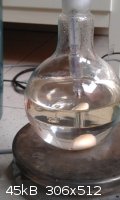 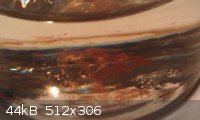
|
|
|
garage chemist
chemical wizard
    
Posts: 1803
Registered: 16-8-2004
Location: Germany
Member Is Offline
Mood: No Mood
|
|
| Quote: | | 98% sulfuric acid consist of 98 mL sulfuric acid and 2 mL water. |
No, it doesn't! Concentrations of acids are always given by weight, in every country! The only percentage that is given by volume is ethanol in
alcoholic drinks.
If you arrived at a different result by titration, then there is another serious misunderstanding that you need to clear up before you can calculate
and use the proper amounts and concentrations of acids and bases in chemical synthesis.
|
|
|
Number 9
Harmless

Posts: 34
Registered: 23-3-2012
Location: Grajagan
Member Is Offline
Mood: ingin tahu semua
|
|
It's amazing!.. the German procedure (source:"Chemie und Technologie der Explosivstoffe" by Tadeusz Urbanski) really works.
Here are some pictures of a mixture of p-nitro chlorobenzene & o-nitro chlorobenzene. Next step is the recrystallisation in a suited solvent. But
I don't know what kind of solvent?
I have more then 100g of these isomers and now try to get pharmaceutical grade p-nitro chlorobenzene to work further.
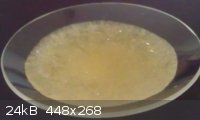 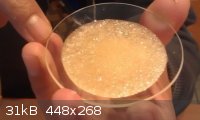
|
|
|
garage chemist
chemical wizard
    
Posts: 1803
Registered: 16-8-2004
Location: Germany
Member Is Offline
Mood: No Mood
|
|
You now have a slush of crystals and liquid, right? You now have to filter off the crystals from the liquid at 20°C, as I have written above, and
press out the filter cake somewhat.
Then wash thrice with cold (ca. 5°C) methanol, and dry the crystals. This is fairly pure p-nitrochlorobenzene. If higher purity is desired,
recrystallize from methanol.
You will need a vacuum filtration setup, gravity filtration doesn't work well for this crystal slush.
|
|
|
Number 9
Harmless

Posts: 34
Registered: 23-3-2012
Location: Grajagan
Member Is Offline
Mood: ingin tahu semua
|
|
Yep, indeed. Now I have the dry crystals and the yellow liquid was filtered apart, just to try to convert it into the liquid 2-amino aniline*
Here is the picture of pure p-nitro chlorobenzene. After drying on several filter papers and finally 3 times washing with cold MeOH.
* you can see it on the background of the pic., it's black after a reduction with Sn turnings/35%HCl & EtOH as solvent. I neutralize it with
NaOH to pH 7 and filter out the solids. Don't know what to think about that black colour?
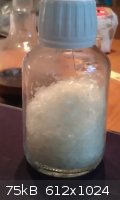
|
|
|